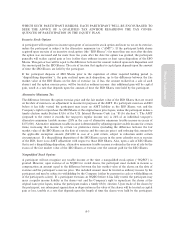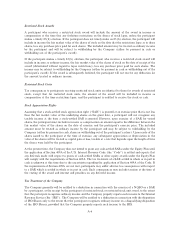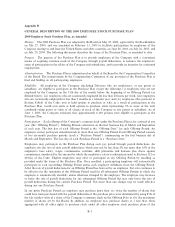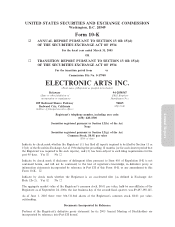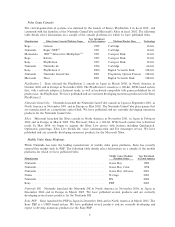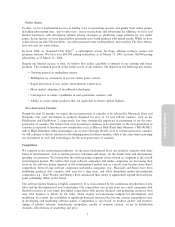Electronic Arts 2005 Annual Report Download - page 53
Download and view the complete annual report
Please find page 53 of the 2005 Electronic Arts annual report below. You can navigate through the pages in the report by either clicking on the pages listed below, or by using the keyword search tool below to find specific information within the annual report.
Company, or any parent or subsidiary of the Company, exceeds $25,000 in fair market value (determined on
the OÅering Date) for each year.
Purchase Price. The purchase price of shares that may be acquired in any Purchase Period under the
Purchase Plan is 85% of the lesser of (a) the fair market value of the shares on the OÅering Date of the
OÅering Period in which the participant is enrolled or (b) the fair market value of the shares on the Purchase
Date. The fair market value of the common stock on a given date is the closing bid price of the common stock
on the immediately preceding business day as quoted on the Nasdaq National Market. On June 1, 2005, the
closing bid price of the Company's common stock was $51.14.
Purchase of Stock. The number of whole shares an employee may purchase in any Purchase Period is
determined by dividing the total amount of payroll deductions withheld from the employee during the
Purchase Period pursuant to the Purchase Plan by the price per share determined as described above, subject
to the limitations described above. The purchase takes place automatically on the last day of the Purchase
Period.
Withdrawal. An employee may withdraw from any OÅering Period at any time at least 15 days prior to the
end of an OÅering Period. No further payroll deductions for the purchase of shares will be made for the
succeeding OÅering Period unless the employee enrolls in the new OÅering Period in the same manner as for
initial participation in the Purchase Plan.
Termination of Employment. Termination of an employee's employment for any reason, including retire-
ment or death, immediately cancels the employee's participation in the Purchase Plan. In such event, the
payroll deductions credited to the employee's account will be returned to such employee or, in case of death, to
the employee's legal representative.
Proxy Statement
Adjustment Upon Changes in Capitalization. The number of shares subject to any purchase, and the number
of shares issuable under the Purchase Plan, is subject to adjustment in the event of a recapitalization of the
Company's common stock. In the event of a proposed dissolution or liquidation of the Company, the OÅering
Period will terminate and the Board may, in its sole discretion, give participants the right to purchase shares
that would not otherwise be purchasable until the last day of the applicable Purchase Period.
Tax Treatment of U.S.-based Participants. Participating employees in the U.S. will not recognize income for
federal income tax purposes either upon enrollment in the Purchase Plan or upon the purchase of shares. All
tax consequences are deferred until a participating U.S. employee sells the shares, disposes of the shares by
gift, or dies.
If shares are held for more than one year after the date of purchase and more than two years from the
beginning of the applicable OÅering Period, or if the employee dies while owning the shares, the employee
realizes ordinary income on a sale (or a disposition by way of gift or upon death) to the extent of the lesser of:
(i) 15% of the fair market value of the shares at the beginning of the OÅering Period; or (ii) the actual gain
(the amount by which the market value of the shares on the date of sale, gift or death, exceeds the purchase
price). All additional gain upon the sale of shares is treated as long-term capital gain. If the shares are sold
and the sale price is less than the purchase price, there is no ordinary income, and the employee has a long-
term capital loss for the diÅerence between the sale price and the purchase price.
If the shares are sold or are otherwise disposed of, including by way of gift (but not death, bequest or
inheritance), within either the one-year or the two-year holding periods described above (in any case a
""disqualifying disposition''), the employee will realize ordinary income at the time of sale or other disposition
taxable to the extent that the fair market value of the shares at the date of purchase was greater than the
purchase price. This excess will constitute ordinary income in the year of the sale or other disposition even if
no gain is realized on the sale or if a gratuitous transfer is made. The diÅerence, if any, between the proceeds
of sale and the fair market value of the shares at the date of purchase is a capital gain or loss. Capital gains
may be oÅset by capital losses, and up to $3,000 of capital losses in excess of capital gains may be oÅset
annually against ordinary income. Ordinary income recognized by an employee upon a disqualifying
disposition constitutes taxable compensation that will be reported on a W-2 form. The Company takes the
position that any ordinary income recognized upon a sale or other disposition is not subject to withholding.
B-2








